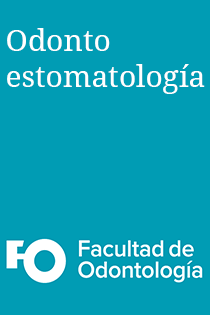Resumo
Objetivo. Explorar o efeito das características da superfície no volume total e viabilidade do biofilme formado em PEEK e pilares
de cicatrização de titânio.
Métodos. Parâmetros de rugosidade (Sa e Sk) e energia de superfície de PEEK e pilares de titânio (n = 3) foram determinados
por microscopia confocal de varredura a laser (CLSM) e ângulo de contato, respectivamente. O volume total e a viabilidade de
um biofilme bacteriano multiespécie cultivado por 30 dias foram então determinados usando CLSM e o reagente LIVE/DEAD
Kit BacLight. O tamanho do efeito foi determinado usando o d de Cohen.
Resultados. Os pilares de PEEK mostraram maior rugosidade do que os de titânio (Sa 0,41 μm vs 0,17 μm), mas não foram observadas diferenças na energia de superfície. Embora o volume total de biofilme tenha sido maior no titânio do que no PEEK (696 μm3 vs 419 μm3), não houve diferenças na proporção de bactérias vivas entre os dois materiais.
Conclusões. A viabilidade do biofilme bacteriano formado não está diretamente relacionada às características da superfície dos pilares de cicatrização de PEEK e titânio.
Referências
Kurtz SM, Devine JN. PEEK biomaterials in trauma, orthopedic, and spinal implants. Biomaterials. 2007;28(32):4845-69.
Ramenzoni LL, Attin T, Schmidlin PR. In Vitro Effect of Modified Polyetheretherketone (PEEK) Implant Abutments on Human Gingival Epithelial Keratinocytes Migration and Proliferation. Materials (Basel, Switzerland). 2019;12(9).
Najeeb S, Zafar MS, Khurshid Z, Siddiqui F. Applications of polyetheretherketone (PEEK) in oral implantology and prosthodontics. J Prosthodont Res. 2016;60(1):12-9.
Rahmitasari F, Ishida Y, Kurahashi K, Matsuda T, Watanabe M, Ichikawa T. PEEK with Reinforced Materials and Modifications for Dental Implant Applications. Dent J (Basel). 2017;5(4).
Wheelis SE, Wilson TG, Jr., Valderrama P, Rodrigues DC. Surface characterization of titanium implant healing abutments before and after placement. Clin Implant Dent Relat Res. 2018;20(2):180-90.
Roehling S, Astasov-Frauenhoffer M, Hauser-Gerspach I, Braissant O, Woelfler H, Waltimo T, et al. In Vitro Biofilm Formation on Titanium and Zirconia Implant Surfaces. J Periodontol. 2017;88(3):298-307.
D’Ercole S, Cellini L, Pilato S, Di Lodovico S, Iezzi G, Piattelli A, et al. Material characterization and Streptococcus oralis adhesion on Polyetheretherketone (PEEK) and titanium surfaces used in implantology. J Mater Sci Mater Med. 2020;31(10):84.
de Avila ED, Avila-Campos MJ, Vergani CE, Spolidório DM, Mollo Fde A, Jr. Structural and quantitative analysis of a mature anaerobic biofilm on different implant abutment surfaces. J Prosthet Dent. 2016;115(4):428-36.
Barkarmo S, Longhorn D, Leer K, Johansson CB, Stenport V, Franco-Tabares S, et al. Biofilm formation on polyetheretherketone and titanium surfaces. Clin Exp Dent. 2019;5(4):427-37.
Hao Y, Huang X, Zhou X, Li M, Ren B, Peng X, et al. Influence of Dental Prosthesis and Restorative Materials Interface on Oral Biofilms. Int J Mol Sci. 2018;19(10):3157.
Jerez-Olate C, Araya N, Alcántara R, Luengo L, Bello-Toledo H, González-Rocha G, et al. In vitro antibacterial activity of endodontic bioceramic materials against dual and multispecies aerobic-anaerobic biofilm models. Aust Endod J. 2022;48(3):465-72.
Cohen J. Statistical power analysis for the behavioral sciences. Second edition.1998.
Busscher HJ, Rinastiti M, Siswomihardjo W, van der Mei HC. Biofilm formation on dental restorative and implant materials. J Dent Res. 2010;89(7):657-65.
Bollen CM, Lambrechts P, Quirynen M. Comparison of surface roughness of oral hard materials to the threshold surface roughness for bacterial plaque retention: a review of the literature. Dent Mater. 1997;13(4):258-69.
Teughels W, Van Assche N, Sliepen I, Quirynen M. Effect of material characteristics and/or surface topography on biofilm development. Clin Oral Implants Res. 2006;17 Suppl 2:68-81.
Ionescu A, Wutscher E, Brambilla E, Schneider-Feyrer S, Giessibl FJ, Hahnel S. Influence of surface properties of resin-based composites on in vitro Streptococcus mutans biofilm development. Eur J Oral Sci. 2012;120(5):458-65.
Haralur SB. Evaluation of efficiency of manual polishing over autoglazed and overglazed porcelain and its effect on plaque accumulation. J Adv Prosthodont. 2012;4(4):179-86.
Pereira da Silva CH, Vidigal GM, Jr., de Uzeda M, de Almeida Soares G. Influence of titanium surface roughness on attachment of Streptococcus sanguis: an in vitro study. Implant Dent. 2005;14(1):88-93.
Song F, Koo H, Ren D. Effects of Material Properties on Bacterial Adhesion and Biofilm Formation. J Dent Res. 2015;94(8):1027-34.
Hahnel S, Wieser A, Lang R, Rosentritt M. Biofilm formation on the surface of modern implant abutment materials. Clin Oral Implants Res. 2015;26(11):1297-301.
Peng TY, Lin DJ, Mine Y, Tasi CY, Li PJ, Shih YH, et al. Biofilm Formation on the Surface of (Poly)Ether-Ether-Ketone and In Vitro Antimicrobial Efficacy of Photodynamic Therapy on Peri-Implant Mucositis. Polymers (Basel). 2021;13(6).

Este trabalho está licenciado sob uma licença Creative Commons Attribution-NonCommercial 4.0 International License.


